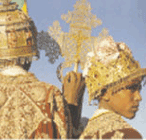|
|
|
|
|
|
|
|
|
|
|
|
|
In
The Queen of Sheba's Footsteps Everything that I
had read about Ethiopia in Wilbur Smith's novels,
the River God and Secret Scroll, was as he
described. As we learned later from Hon. Yusuf
Abdullahi Sukkar, Ethiopia's Tourism Commissioner,
airport construction enjoys a high priority, and on
the high plain south of Lalibela, a new terminal
building is in the final stages of completion. Our
temporary waiting area was a baggage shack, where
we basked in the morning sun, awaiting the commuter
bus. A
Storybook Land:
I've never been to Tibet, but the spiritual
presence and views we saw during our corkscrew
journey up the hillside would easily fit that
image. Small wonder this storybook land has such a
spiritual presence, a proud tradition and a way of
life that has survived three millennia, despite an
outside world of hate, conquest, treachery, trial
and turmoil. The thatched villages, shepherd boys,
terraced farming methods, simple forms of
irrigation and donkey power, attest to the fact
that time has stood still &emdash; as well it
should. Coming from North America it's hard for us
to realize that this is the way it has been in this
part of the world since time immemorial. Rocks
of Ages: During
my recent African excursions, I have been awed by
mankind's glorious creations, offset by a Jekyll
and Hyde capacity for evil. While we were shocked
by the slave castles of West Africa's Gold Coast
and Zanzibar's dungeons, we saw the result of godly
forces at work in the 12th century rock -hewn
churches that have made the Holy City of Lalibela a
magnet for Christian pilgrims and historians.
Many come for the
famous church festivals in Ethiopia, such as Timket
(Epiphany) and other times of celebration and
devotion. Souvenirs of King Lalibela are
everywhere, as a continuing tribute to his glory
and greatness in creating these wonders of the
world. Our official photographer, Robert Eilets
couldn't get over the abundance of photo
opportunities in Lalibela's streets, at the famous
stone churches and around every bend in the road
leading to this remote highland community. Next
time, we vowed to allow an extra day for
photography alone. Footnote:
Back in Addis Ababa, it was our turn to be
interviewed -- this time by Ethiopian press, radio
and television. To a person, each journalist agreed
it was a positive experience with no feelings of
concern or anxiety about personal health and
safety. The climate in mid February was perfect,
and the hospitality of the people was second to
none. What a beautiful prelude to the ATA congress,
Africa's 1st major tourism event of the new
millennium.
More
to come, including map and photos. Continued: (Holy
Route North)
Gondar- Ethiopia's Camelot
|










 x
Lalibela's
Bet
Giyorgis, most famous of the eleven rock-hewn
churches in this mountainous area, is believed to
have been built in the late 12th or early 13th
century by King Lalibela. These incredible
edifices, which were carved inside and outside from
solid rock, are ranked among the wonders of the
world. Our
team of North American journalists came to Ethiopia
with few preconceived notions, yet each had some
special areas of concern. For every member of the
group, it was a first time journey to this ancient,
mysterious, storybook land. What a spiritual
awakening it proved to be. The tour of Ethiopia's
Historic Route began in Addis Ababa, the capital
and geographical center. For starters, Ethiopian
Airlines, flew us north to Lalibela, the holy city;
to Gondar- Africa's Camelot, and to Bahir Dar on
Lake Tana, source of the Blue Nile. Dire Dawa and
the walled city of Harar in the eastern sector
completed the agenda.
x
Lalibela's
Bet
Giyorgis, most famous of the eleven rock-hewn
churches in this mountainous area, is believed to
have been built in the late 12th or early 13th
century by King Lalibela. These incredible
edifices, which were carved inside and outside from
solid rock, are ranked among the wonders of the
world. Our
team of North American journalists came to Ethiopia
with few preconceived notions, yet each had some
special areas of concern. For every member of the
group, it was a first time journey to this ancient,
mysterious, storybook land. What a spiritual
awakening it proved to be. The tour of Ethiopia's
Historic Route began in Addis Ababa, the capital
and geographical center. For starters, Ethiopian
Airlines, flew us north to Lalibela, the holy city;
to Gondar- Africa's Camelot, and to Bahir Dar on
Lake Tana, source of the Blue Nile. Dire Dawa and
the walled city of Harar in the eastern sector
completed the agenda.  Nothing
I had read about the Holy City of Lalibela, its
mysteries, legends, saints and monarchs, could have
prepared me for what we were about to encounter on
this trip. The brief morning flight from Addis
Ababa's Airport north was a delight, winging
through the cloudless skies, as an ever-changing
panorama of awesome gorges, deep canyons and broad
plateaus unfolded below.
Nothing
I had read about the Holy City of Lalibela, its
mysteries, legends, saints and monarchs, could have
prepared me for what we were about to encounter on
this trip. The brief morning flight from Addis
Ababa's Airport north was a delight, winging
through the cloudless skies, as an ever-changing
panorama of awesome gorges, deep canyons and broad
plateaus unfolded below.